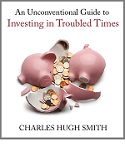

|

|
|||||||||||||
|
When Escape from a Previously Successful Model Is Impossible (November 29, 2012) Three visualizations describe the breakdown of PSMs--previously successful models: S-Curves, Supernovas and Rising Wedges. A successful model traps those within it; escape becomes impossible. I recently highlighted one historical example of a PSM (Previously Successful Model) in Our Dust Bowl Economy (November 20, 2012): in the ample-rain era of the 1920s, farmers in the semi-arid southern Midwest had reaped huge profits by plowing up and planting fragile native grasslands. They poured their profits into homesteads, equipment and more land to enable further expansion. When grain surpluses pushed prices down, their "model" had only one "solution": plant more land and harvest even more grain to compensate for lower prices. When prices fell from $1 per bushel to $.25/bushel, the model collapsed. This previously successful model exacerbated the Dust Bowl and left the trapped farmers with no alternative but to either keep trying to make a failed model work or leave and abandon all their sunk capital in land, homes and farm equipment. A more current example can be found in Microsoft (MSFT a.k.a. Mister Softee), whose previously successful model took a 42% marketshare in smartphones and reduced it to 2%. Here is an excerpt from Microsoft has failed (semiaccurate.com):
I would generalize that the Microsoft model of buying competitors and stitching together quasi-monopolies has failed: first in mobile, next in tablets and eventually in operating systems and Office. We see the immense power of previously successful models. Straying from the previously successful trajectory looks needlessly risky, even as the trajectory has rolled over and is heading for unpleasant impact. Anyone who questions the previously successful model (PSM) is suppressed, fired or sent to Siberia as a "threat" to the enterprise's success. Anyone who realizes the Titanic will inevitably sink and abandons ship leaves behind all their sunk capital: they leave with the figurative clothes on their back. I have often covered the S-Curve model of initial development, rapid growth, eventual stagnation and collapse. Here is an example showing how financialization has peaked and will collapse: Our "Let's Pretend" Economy: Let's Pretend Financialization Hasn't Killed the Economy (March 8, 2012).
Since most of the systems and fiefdoms that are trapped in previously successful models are bureaucracies, we can also profitably use the "Supernova" model of rapid expansion, brief equilibrium and sudden collapse: The Lifecycle of Bureaucracy (December 2, 2010):
I have often addressed the way that bureaucracies arise to solve a problem and quickly progress to becoming an even bigger and more intractable problem themselves, generally because they only know how to expand (the ratchet effect) and have no institutional ability to shrink or become more efficient: Complexity: Bureaucratic (Death Spiral) and Self-Organizing (Sustainable) (February 17, 2011) Failure: Don't Despair, It's The New Normal (May 4, 2011) Global Crisis: the Convergence of Marx, Orwell and Kafka (July 25, 2012) We can also visualize PSMs (Previously Successful Models) as a rising wedge, a pattern well-known to technical analysis. The previously successful model essentially charts an expansionary course that the organization is locked into. As the model fails to produce results, inefficiencies and costs rise, pushing the lower boundary of failure ever closer to the actual revenues.
Once the revenues fall below this threshold of viability, the organization breaks down, as there is no organizational capacity to radically reduce costs and headcount while significantly increasing efficiency and return on investment.
This model of breakdown describes all the major systems of local and Federal Government:
the Pentagon, Medicare, Medicaid, Social Security, the higher-education/student loan cartel,
the mortgage/housing cartel, sickcare, and so on.
My new book Why Things Are Falling Apart and What We Can Do About It is now available in print and Kindle editions--10% to 20% discounts.
Things are falling apart--that is obvious. But why are they falling
apart? The reasons are complex and global. Our economy and society have structural
problems that cannot be solved by adding debt to debt. We are becoming poorer, not
just from financial over-reach, but from fundamental forces that are not easy to identify
or understand. We will cover the five core reasons why things are falling apart:
 1. Debt and financialization
1. Debt and financialization
2. Crony capitalism and the elimination of accountability 3. Diminishing returns 4. Centralization 5. Technological, financial and demographic changes in our economy Complex systems weakened by diminishing returns collapse under their own weight and are replaced by systems that are simpler, faster and affordable. If we cling to the old ways, our system will disintegrate. If we want sustainable prosperity rather than collapse, we must embrace a new model that is Decentralized, Adaptive, Transparent and Accountable (DATA).
We are not powerless. Not accepting responsibility and being powerless are two sides of
the same coin: once we accept responsibility, we become powerful.
To receive a 20% discount
on the print edition: $19.20 (retail $24), follow the link, open a Createspace account and enter
discount code SJRGPLAB. (This is the only way I can offer a discount.)




Please click on a book cover to read sample chapters
NOTE: gifts/contributions are acknowledged in the order received. Your name and email remain confidential and will not be given to any other individual, company or agency.
"This guy is THE leading visionary on reality.
He routinely discusses things which no one else has talked about, yet,
turn out to be quite relevant months later."
Or send him coins, stamps or quatloos via mail--please request P.O. Box address. Subscribers ($5/mo) and contributors of $50 or more this year will receive a weekly email of exclusive (though not necessarily coherent) musings and amusings. At readers' request, there is also a $10/month option. What subscribers are saying about the Musings (Musings samples here): The "unsubscribe" link is for when you find the usual drivel here insufferable.
All content, HTML coding, format design, design elements and images copyright © 2012 Charles Hugh Smith, All rights reserved in all media, unless otherwise credited or noted. I am honored if you link to this essay, or print a copy for your own use.
Terms of Service:
|
Add oftwominds.com |